You are using an out of date browser. It may not display this or other websites correctly.
You should upgrade or use an alternative browser.
You should upgrade or use an alternative browser.
The Italian Invasion
- Thread starter Todd A
- Start date
Todd A
pfm Member
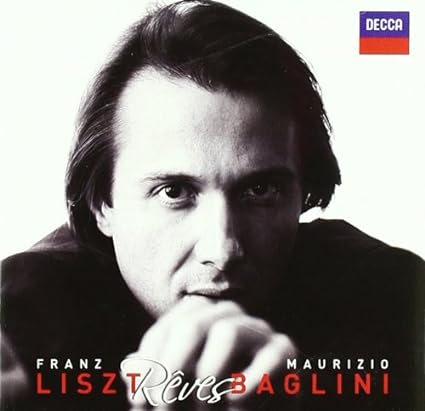
Release twenty-three, disc twenty-six. More Liszt from Maurizio Baglini. Some lesser Liszt. This assortment includes the first Mephisto Waltz, the Valse oubliee, all six Grande Etudes d'apres Paganini, the Grande Fantasie de bravoure sur La Clochette, the second Hungarian Rhapsody, and finally Liebestraum the famous one.
The first Mephisto Waltz starts things off, and it offers a significantly different take from young Kit Armstrong's interpretation I listened to recently. Baglini is the more romantic of the two, throwing in rubato liberally and establishing a sense of free virtuosity in contrast to Armstrong's studied display of keyboard wizardry. I like both equally well. Baglini dashes off the Valse oubliee, and the Grand Etudes are all superbly played. La Campanella is its old reliable, crowd-pleasing self, and La Chasse here sounds like a forgotten Scarlatti sonata embellished by Liszt. What's not to like about that? The Grande Fantasie is vast and sprawling and filled with gobs of notes begging to be played in as flashy a manner as possible. Baglini does his level best to meet the demand. The Second Hungarian Rhapsody receives as close to a quasi-symphonic reading as I have heard, with Baglini's right hand playing combining with the bright Fazioli sound to emulate a string section more effectively than I would have imagined. Liebestraum offers a fine closer.
This set lacks the heft of Liszt's better works the Annees, the Harmonies, the Consolations, the Transcendental Studies, the Sonata but the disc is superb as a recording of virtuosic Liszt.
Top shelf sound.
Amazon UK link
This site contains affiliate links for which pink fish media may be compensated.
Todd A
pfm Member
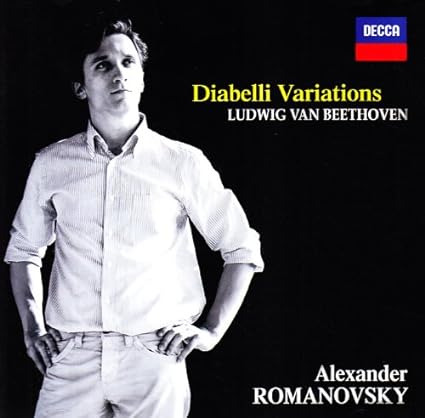
Release twenty-four, disc twenty-seven. Russian born, now Italian domiciled Alexander Romanovsky playing the Diabellis. The first of four recordings from the pianist. The first thing one notices about the playing is that Romanovsky is not a speed demon. His playing is not particularly slow, but he's not out to dazzle with unlimited speed, at least in this recording. Second is the big sound, heavy yet a bit bright and metallic at times. It's not unattractive. It lends itself to establishing a monumental performance of the piece. Third, the theme and variations are all extremely well executed, but they tend to assume a certain sameness. Each variation sounds fine, is loud when it should be, witty when it should be, and so on, but something seems to be missing. This is a good enough recording of the work, but it just doesn't catch fire. I'm betting Romanovsky sounds swell in Rachmaninoff, and I will soon find out.
Amazon UK link
This site contains affiliate links for which pink fish media may be compensated.
Todd A
pfm Member
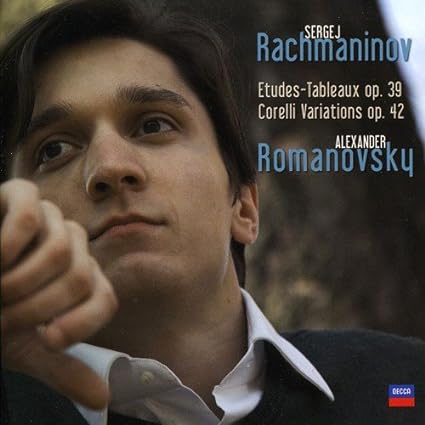
Release twenty-five, disc twenty-eight. Alexander Romanovsky playing Rachmaninoff. As expected, Romanovsky sounds swell. His big, rich, dark-hued sound lends itself well to the Op 39 Etudes Tableuax and Corelli Variations. He has no problem playing the music, and the Etudes sound vast is scale, and his quieter playing is better here than in the LvB. His approach, not surprisingly, is very similar in the Corelli Variations, and while supremely well played, and sounding rich, he simply cannot match up to the greater flexibility, verve, dash, and panache of Daniil Trifonov. This recording is very good and enjoyable, but his fellow countryman's is brilliant in every regard. That written, this is an excellent disc and I look forward to the next Rach disc
Amazon UK link
This site contains affiliate links for which pink fish media may be compensated.
Todd A
pfm Member
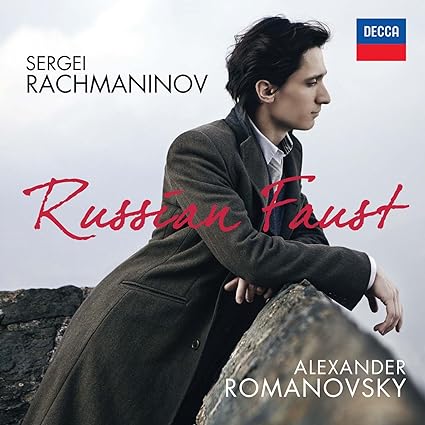
Release twenty-six, disc twenty-nine. More Alexander Romanovsky playing Rachmaninoff, this time the piano sonatas. I rarely listen to these works. For the first, the only other version I recall having heard is Robert Silverman's. Romanovsky's strikes me as more assured, and maybe even romantic in approach, and even if the work is just a bit too long, Romanovsky plays with enough beauty and tenderness, especially in the second movement, and he creates a vast, weighty sound and drama elsewhere. It is late romanticism in all its glory. Ditto the second sonata, which Romanosky plays likewise very well. Here the Non allegro movement contains the best playing of the disc, where Romanovsky coaxes great beauty from his instrument. The outer movements sound suitably virtuosic and romantic. I still prefer Kocsis to all comers here, and Cliburn is not without his merits, or Ashkenazy, for that matter, but this is the best of the three Romanovsky discs so far. Superb sound.
Amazon UK link
This site contains affiliate links for which pink fish media may be compensated.
Todd A
pfm Member
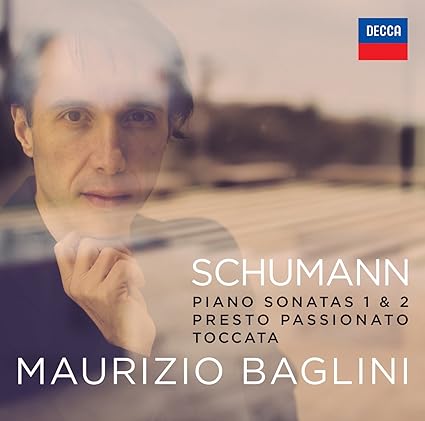
Release twenty-seven, disc thirty. Maurizio Baglini playing more Schumann, this time the Opp 11 and 22 sonatas, with the original finale for Op 22 and the Toccata thrown in.
The disc opens with Op 22, and there's no reason to beat around the bush: this is one of the best versions of Op 22 I've heard. The most immediately notable thing about the playing is how tender and gentle much if it is. Baglini has figured out, with the help of the recording engineers, how to completely tame the Fazioli's upper registers, because this recording sounds warm and soft-edged at times almost ''dreamy'' almost for the duration. It is really quite extraordinary. That's not to write that this is soft-edged and mushy and inappropriate music-making, because it is simply gorgeous and echt-romantic and soft and stormy and tumultuous ad everything I want it to be. Hearing the original finale both reinforces the wisdom of Schumann in updating the work and the originality of the original conception.
Op 11 follows. Baglini effectively applies the Florestan & Eusebius approach here, with the Adagio and slower themes of the Allegro vivace sounding uncommonly dreamy and fantasia-esque and the faster sections unabashedly virtuosic. The Aria sounds gorgeous, though the pedaling may be excessive for some, and then the Scherzo sounds as though it could belong in Carnaval, both stylistically and qualitatively. Baglini wraps up the sonata with another very much Florestan & Eusebius Finale, with the slower music extended just a bit, and with the faster passages displaying decent dollops of rubato and virtuosic flair and healthy doses of romanticism. The Fazioli sounds bright at times and mellow at times, big and small, hefty and light, and everything else.
The disc closes out with the Toccata. Baglini throws in personal rubato and dynamic touches, and almost succeeds in making the piece sound more interesting than it is.
SOTA sound.
Destined to be one of my purchases of the year, even with the Toccata.
Amazon UK link
This site contains affiliate links for which pink fish media may be compensated.
Todd A
pfm Member
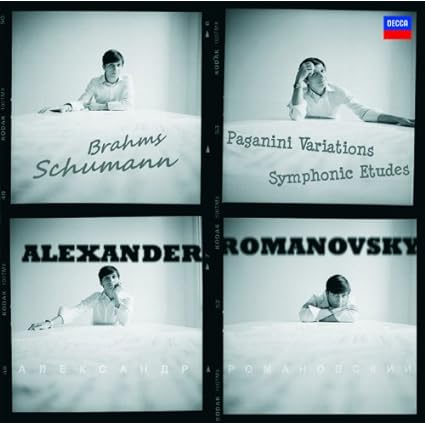
Release twenty-eight, disc thirty-one. The fourth of four discs from Alexander Romanosky. Some Schumann and Brahms. The disc opens with the Symphonic Etudes, with posthumous variations included. Right from the start, this is slow, romantic reading. With warmer sonics, it would have been outright lush. While Romanovsky can clearly play the most virtuosic passages with ease, and he does, he spends more time lavishing loving attention on quieter, gentler music, deploying subtle rubato to good effect, and creating a ''poetic'' atmosphere, for lack of a better word. (One can almost envision reading Keats to a loved one to the fifth posthumous variation.) The only real or potential drawback here is the ordering of the posthumous variations. The first one comes after the first standard variation, disrupting the music flow. On the other hand, the final posthumous variation is placed right before the finale, making for an even more dramatic than normal contrast in music. Superb.
The Brahms Paganini Variations follows, and it is similar in conception. There are more moments of outright virtuosity here, but rather like Ilona Timchenko, Romanovsky plays the 11th and 12th Variations very delicately, to superb effect, but Romanovsky has a more vigorous and enveloping way of manhandling the keyboard when needed. Overall, it seems somewhat studio-bound, a bit too restrained, but nonetheless make for a very enjoyable twenty-two or so minutes of music-making.
Superb sound. So, for me, Romanovsky is sort of two out of four. Depending on what he records next, I may or may not take the plunge. If it's Scriabin, say, I'll take the plunge.
Amazon UK link
This site contains affiliate links for which pink fish media may be compensated.
Todd A
pfm Member
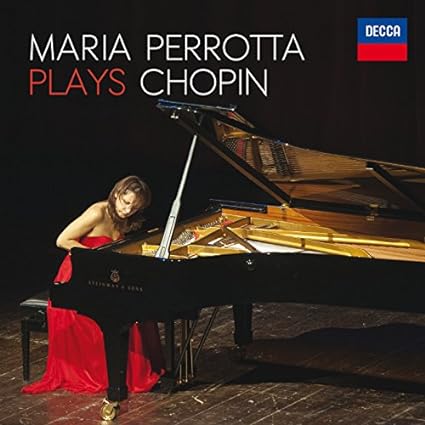
Release twenty-nine, disc thirty-two. Maria Perrotta playing Chopin. The disc opens with the Op 9 Nocturnes. Perotta starts off playing lovely, if perhaps a bit formally, and largely maintains that style for the first two pieces, and then plays with more grit and intensity in the third. The Berceuse, with some halting playing at the outset, sounds largely lovely and flowing. The Op 43 Tarantelle, a piece I don't often listen to, is, despite its short duration, played in a large of scale and rather bull in a china shop style, though its not unattractive. The Andante Spianato et Grande Polonaise Brillante kicks off with a beautiful and largely gentle Andante Spianato, but then the Grande Polonaise Brillante lurches into being, with playing bordering on the garish and ugly, before settling into something more formally virtuosic most of the time, though some of the playing veers back toward unpleasantness from time to time. The playing lacks the flexibility and lightness that better versions bring. The Fourth Ballade alternates between some lovely playing and some slightly unpleasant louder playing. The disc closes with the biggie, the Third Sonata. Perrotta opens the Allegro maestoso with a heavy hand, and some of the playing sounds a bit clunky. The Scherzo fares a bit better, but isn't the last word in control. (It doesn't help matters that memories of Joseph Moog playing the same work in recital only weeks ago with absolute technical command highlights what's missing here) The Largo is very slow indeed, and generally beautiful and subdued, but it kind of meanders and lacks focus. The Finale is more succesful, big in scale and serious in demeanor and well played and full of verve. But the sonata is not a success on the whole, nor is the disc. Alas, this disc is not up to Perotta's prior two recordings of Beethoven and Bach.
Sound is superb for a modern live recording.
Amazon UK link
This site contains affiliate links for which pink fish media may be compensated.
Todd A
pfm Member

Release thirty, discs thirty-three and thirty-four. Roberto Plano plays Liszt's Harmonies. The last of the complete sets of my recent exploration of complete sets. Plano takes a broad view tempo-wise, requiring just shy of ninety minutes for the work. His playing tends to sound a bit more fluid than Pascal Amoyel's or Boris Bloch's similarly timed renditions, though it lacks the serenity and devotion of Amoyel. (Pretty much everyone shy of Richter, and then only in a few pieces, does too.) It has a few spots of mild personal, willful touches subtle use and purposive non-use of the pedals, subtle dynamic gradations and the tonal and dynamic resources of the Fazioli are nicely used. Plano plays with immense scale and weight in the Invocation, for instance, and the right hand runs near the end of the Benediction are simply fantastic, though they do not have Michel Block's heavenly sense of purpose. Pensee des morts sounds a bit episodic and lacks the unleashed power of Yury Favorin, say, though clearly Plano's conception is different. Plano takes full advantage of the Fazioli's bass in Funerailles, opening with thundering yet not hard-edged playing adequate to rattle the walls at high volumes. The piece is somewhat restrained in even the most boisterous passages, and in the middle it takes on a solemn, delicately sorrowful mien before Plano unleashes the bottom octaves to grand effect, and shows how long and well the Fazioli can sustain in the coda. The Miserere d'apres Palestrina is as grand in scale and quasi-orchestral as any Liszt playing I've heard. (Faziolis seem to accomplish this handily.) In contrast, the Andante lagrimoso is slow and largely subdued, and Plano plays each note with the utmost fastidiousness. Plano ends the main work with a wonderfully scaled Cantique d'amour. He also sees fit to throw in an encore in the form of the Third Consolation, and he plays it well enough that I hope he gets to record them all, and that he gets to record some Chopin. The Nocturnes, say.
On the whole, an extremely satisfying recording of the complete Harmonies. Plano doesn't offer the absolute command and sweep of Michael Korstick, the unabashed and intense virtuosity of Favorin, or the hypnotic devotion of Amoyel, but his recording has its own mix of strengths, and no weaknesses of note, and is one I will return to again for sheer enjoyment.
The sound of the 2015 recording, made in Fazioli Hall, using the ''Merlin the Magician'' Fazioli F278 a nickname apparently bestowed by Aldo Ciccolini is SOTA in every regard, as every recording from that venue seems to be. English notes are first in the booklet, hinting at international release, though it was in Italy only when I bought.
Amazon UK link
This site contains affiliate links for which pink fish media may be compensated.
Todd A
pfm Member
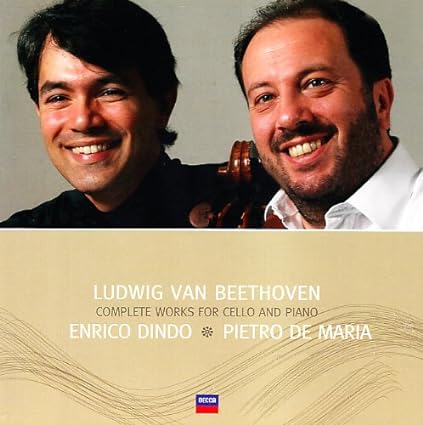
Release thirty-one, discs thirty-five and thirty-six. Enrico Dindo and Pietro De Maria play Beethoven's works for cello and piano. I'm gonna come clean, I bought this set only because Pietro De Maria is the pianist and it popped up on the UMG Italy site recently. The set, though, is actually older, having been recorded in 2004 and initially released in 2005.
The recorded balance favors Dindo, whose tone is full and solid. His playing is solid throughout, though here and there it is a bit stiff. I could have used with more fiery playing in a few spots, and more fun and lively and flexible playing in the variation works from time to time. Pietro De Maria's playing is both solid and unfailingly elegant throughout. His playing in the WoO 45 variations (the Handel Judas Maccabaeus job) offers more than a few moments where he comes to the fore, and it makes me think he could really deliver some fine early LvB sonatas. Hopefully, he'll record at least some for the upcoming celebration years.
I decided to compare this all Italian duo to another all Italian duo in the first sonata. That other duo is Andrea Lucchesini and Mario Brunello, in their 1996 recording of the complete works. Lucchesini and Brunello play much slower about two minutes a work across the set and produce a more unabashedly romantic sound, and one that fairly sings. The artists are more equal, as well, with Lucchesini's piano more balanced in the mix. Too, the piano sounds weightier. How to decide which is better? It could very well be a mood thing. OK, I prefer Lucchesini/Brunello, but it's best to have both sets, and a bunch of others, including my reference Schiff/Perenyi.
Excellent sound.
Amazon UK link
This site contains affiliate links for which pink fish media may be compensated.
I take the liberty of two more suggestions from Italy:
https://www.amazon.it/Chopin-Sacd-L...=1464692630&sr=1-2&keywords=leonora+armellini
I can't write a review, but she's great and that record is, too; moreover, a very good recording.
another arising artist is Beatrice Rana:
https://www.amazon.it/s/ref=nb_sb_n...ch-alias=popular&field-keywords=beatrice+rana
I don't know her records but I saw her live in Milan; she may be not at the same level as De Maria or Prosseda, but... "growing" (don't know if this word is correct)
https://www.amazon.it/Chopin-Sacd-L...=1464692630&sr=1-2&keywords=leonora+armellini
I can't write a review, but she's great and that record is, too; moreover, a very good recording.
another arising artist is Beatrice Rana:
https://www.amazon.it/s/ref=nb_sb_n...ch-alias=popular&field-keywords=beatrice+rana
I don't know her records but I saw her live in Milan; she may be not at the same level as De Maria or Prosseda, but... "growing" (don't know if this word is correct)
Todd A
pfm Member
another arising artist is Beatrice Rana:
https://www.amazon.it/s/ref=nb_sb_n...ch-alias=popular&field-keywords=beatrice+rana
I don't know her records but I saw her live in Milan; she may be not at the same level as De Maria or Prosseda, but... "growing" (don't know if this word is correct)
Rana's Atma disc (Chopin/Scriabin) is quite good.
Todd A
pfm Member
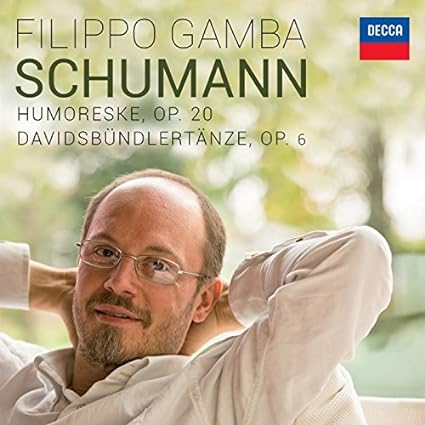
Release thirty-two, disc thirty-seven. Filippo Gamba plays Schumann's Humoreske and Davidsbündlertänze. Though issued by Decca in 2015, these recordings were not made by Decca. The live recordings date from 1999 (Humoreske) and 2001 (Davidsbündlertänze) in what sound like private/archive/amateur recordings. That ends up being a problem.
Humoreske sounds just awful. The playing seems good enough, with Gamba displaying what seems like a nice dynamic range and quickness and nimbleness, but the sound is sometimes harsh, sometimes unsteady and wobbly, sometimes very early MP3 codec sounding in the highs, though with analog hiss thrown in the mix. Sometimes there's a little distortion. Sometimes there's a lot. Quiet music sounds the worst, and is a chore to endure. It's not as bad sonically as Dino Ciani's LvB cycle, but it's shockingly close for something recorded at the very end of last century.
Davidsbündlertänze sounds comparatively better, though by no means is it close to SOTA for recital recordings circa 2001. Gamba does display some fine control and nuance in the quieter, gentler music indeed, it's the best thing about the disc and despite some passages that betray the live nature of the recording, the louder and faster playing is hefty and powerful, though perhaps bordering on not quite under control, though that could be the congested, harsher nature of the recording in louder music. Even making allowances for sound, this is not an Op 6 for the ages.
I wish I would have known about the recording dates and sources before buying. I get why well-established (cult-y?) artists have every conceivable recording released, irrespective of provenance or quality, by big companies and pirate operations alike (think Richter), but Gamba isn't one of those artists. The disc is dud.
Todd A
pfm Member

Release thirty-three, disc thirty-eight. Vanessa Benelli Mosell plays Scriabin and Stockhausen in a disc called Light. If the last Decca release took advantage of Ms Benelli Mosell's attractiveness, this one goes over the top in trying to exploit it. The cover shot, with her donning a garish, glittery red dress and handsome red high heels, is augmented by multiple professional, properly photoshopped glamour shots in the booklet, on the back cover, and in the disc holder. There's a nice, discreet cleavage shot, and in one spread that takes up about one and a quarter pages in the back of the booklet (and the disc holder), she wears a white lace job, though the red shoes do clash with the dress. This is one of the rare discs I own where a shout out is given to a fashion designer. Since the artist is the sole credited producer of the disc, I have to assume this is all her own doing. It seems a bit much for a classical release, but hey, flaunt it if you got it.
To the music, Ms Benelli Mosell offers up Scriabin's Op 11 Preludes, 3 Pieces Op 2, and a solitary selection from the Op 8 Etudes to start the disc, and the second half is given over to Stockhausen's Klavierstücke XII, derived from three Examen from the opera Donnerstag aud Licht. Benelli Mosell's Scriabin is not of the tonally lustrous, gently nuanced school of interpretation. Much of her playing is either quick and light or quick and a bit heavy, with very slight tinges of metal. Some of the slower pieces offer a bit more nuanced playing, but Benelli Mosell doesn't overdue the pedalling or legato or rubato. It's sort of cold-water Scriabin. It doesn't match, say, Lettberg or Ashkenazy in the miniatures they have recorded, but if ever the pianist opts to record the sonatas, I do think I'd give them a shot.
Next is the over twenty minute helping of Stockhausen. This music is new to me. Pretty much throughout, the piano music is accompanied by some non-musical elements: talking, some counting auf Deutsch, finger snapping, kissing sounds, hissing sounds, whistling, and so forth. There's some string strumming, too. The vocalizing and gimmicks unfortunately detract from the piano music, which I find more compelling than the earlier Klavierstücke Ms Benelli Mosell recorded. And the pianist does seem to be on top of it, maintaining a keen rhytmic sense when one can be heard, as well as fine dynamic gradations, and firm control throughout. I get the sense that she has more Stockhausen to record in some other concept discs.
Sound is fully modern, strikingly clear, and a bit cold and hard, for lack of a better description.
Amazon UK link
This site contains affiliate links for which pink fish media may be compensated.
Todd A
pfm Member
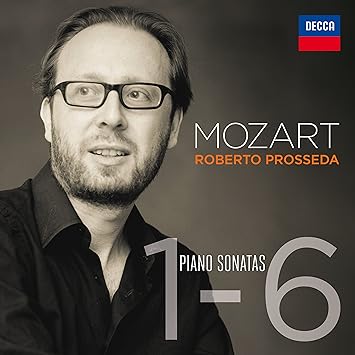
The latest batch of UMG Italy discs starts off with the first twofer of a Mozart sonata cycle played by Roberto Prosseda. Brand spankin' new, having been recorded in November 2015 and January of this year, this set offers two novelties to set it apart from other cycles in the crowded marketplace: it is played on a Fazioli, and said Fazioli is tuned using Vallotti unequal temperament. The set includes the first six sonatas, along with a first draft fragment of the first movement of K284.
To the playing first, Prosseda is an interventionist. He throws in ornamentation liberally and, for the most part, effectively. It blends stylistically and works comparatively better than Paavali Jumppanen's ornamentation in early Beethoven. Sometimes it may be a bit too much, like in the Andante of K283, but then again maybe not. Prosseda also deploys rubato liberally, and his dynamic gradations are very fine, with a great deal of piano to pianissimo variation. The sonatas all stay reasonably light, all sound lovely and engaging, and though the numerous personal touches often sound more studied than spontaneous, the set works well because of the personal touches. Earlier this year I picked up Siegfried Mauser's equally interventionist set, and if Prosseda's set doesn't have the same impact and depth as Mauser's, it is good to hear another new and unique set.
Now to the piano sound. Sonics, as with every recording I've heard made in Fazioli Hall, are SOTA. The piano sounds warmer than normal for a Fazioli, while retaining the clarity, and sometimes sounds velvety and sometimes downright gorgeous. The piano tone at times ranks among the most beautiful I've heard. How much is the tuning, how much the playing, how much the recording, I don't know. I do know that I look forward to the remaining discs in the cycle.
Amazon UK link
This site contains affiliate links for which pink fish media may be compensated.
Todd A
pfm Member
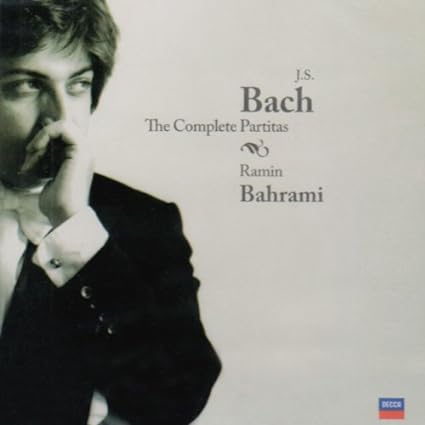
Next up, more Bach from Ramin Bahrami, this time the complete Partitas from 2005. The playing is generally swift, well-articulated, rythmically solid, and gently relentless in its forward drive. Melody is probably a bit dominant overall, but not by much, and Bahrami uniquely highlights some figurations. But there's a certain sameness to the polished playing. His playing is quite fine, but it lacks that certain something that someone like Schiff (ECM) or Anderszewski can bring. It almost ends up as background Bach.
Sound is fully modern, though set a bit high in level, and dynamic range is not the widest I've heard.
Amazon UK link
This site contains affiliate links for which pink fish media may be compensated.
Maxbertola
pfm Member
Todd,
thanks for this excellent survey and set of reviews.
I can add a few details on some of these artists, because some of them have studied in the Music Conservatory in Milano, where I teach Harmony, Counterpoint and Composition.
Ramin Bahrami was a young student in 1997, when I moved to Milano from Torino, and a piano classmate of a composition student of mine. My student used to speak highly of him, I met him a couple of times, a very quiet and mannered young boy (who used to look at Glenn Gould and his aesthetics, a not yet so common thing among pianists).
Francesca Dego and Francesca Leonardi are too both from the Conservatorio in Milano, and I personally know Francesca Leonardi because she attended a course of mine, in harmonic writing techniques. That year the programme of the course was writing a cadenza for a Concerto from the Classical period – we mostly worked on Mozart. She did very well. Not much later she began her career. She gave a copy of her very first CD with Dego to me, not yet from a renown label.
As for Enrico Dindo, we studied in the same Conservatory, in our native Torino. I've known him for many years.. His father was a tenor and a lutist (who made the first instruments for his children), and his sister a viola player in the National Radio Symphonic Orchestra. Please note that in 1997 Enrico won the Rostropovich First prize in Paris. I understand that you prefer Mario Brunello (I've met him through my brother, who's a cellist too), but Enrico Dindo is today as celebrated a cellist as his colleague from Veneto.
It was a nice surprise for me to find here such a catalogue of Italian artists, a few of whom I know: I only come to PFM for audio reasons... But tonight I have re-encountered a number of musicians from the same musical institution I work in – with some pride, I must add.
Thanks,
Massimo
thanks for this excellent survey and set of reviews.
I can add a few details on some of these artists, because some of them have studied in the Music Conservatory in Milano, where I teach Harmony, Counterpoint and Composition.
Ramin Bahrami was a young student in 1997, when I moved to Milano from Torino, and a piano classmate of a composition student of mine. My student used to speak highly of him, I met him a couple of times, a very quiet and mannered young boy (who used to look at Glenn Gould and his aesthetics, a not yet so common thing among pianists).
Francesca Dego and Francesca Leonardi are too both from the Conservatorio in Milano, and I personally know Francesca Leonardi because she attended a course of mine, in harmonic writing techniques. That year the programme of the course was writing a cadenza for a Concerto from the Classical period – we mostly worked on Mozart. She did very well. Not much later she began her career. She gave a copy of her very first CD with Dego to me, not yet from a renown label.
As for Enrico Dindo, we studied in the same Conservatory, in our native Torino. I've known him for many years.. His father was a tenor and a lutist (who made the first instruments for his children), and his sister a viola player in the National Radio Symphonic Orchestra. Please note that in 1997 Enrico won the Rostropovich First prize in Paris. I understand that you prefer Mario Brunello (I've met him through my brother, who's a cellist too), but Enrico Dindo is today as celebrated a cellist as his colleague from Veneto.
It was a nice surprise for me to find here such a catalogue of Italian artists, a few of whom I know: I only come to PFM for audio reasons... But tonight I have re-encountered a number of musicians from the same musical institution I work in – with some pride, I must add.
Thanks,
Massimo
Todd A
pfm Member
Massimo, I was very excited when I found out about the wealth of recordings available from UMG Italy last year. Here was mostly core rep being played by younger artists. While I most certainly appreciate established artists of the past, it is the young and new artists who will carry classical music forward, and I derive much pleasure from hunting down recordings from promising talents. So far, the experience has been very rewarding, and disappointments slight, and only in areas of personal preference. (Well, except for the objectively poor sound quality in the second Gamba disc.) I've mostly focused on pianists, but UMG Italy has recorded some other artists and ensembles as well. Italian conservatories do seem to be producing some very, very fine artists.
It was reassuring to find some national focus not just in Italy, but elsewhere. Sony Classics Germany does something similar, and while I've explored fewer recordings from that source, I did find Thomas Hengelbrock, and I rate him among the finest conductors working today. EMI France, specifically the Parlophone label, similarly used to produce local market recordings with French artists, and I hope Warner will allow it to continue. And then there is the Japanese market, where all the major labels and some local only labels produce large volumes of classical recordings, often in the best sound available. There is still a lot to hear, still a bright future for performances and recordings. I am grateful for that.
It was reassuring to find some national focus not just in Italy, but elsewhere. Sony Classics Germany does something similar, and while I've explored fewer recordings from that source, I did find Thomas Hengelbrock, and I rate him among the finest conductors working today. EMI France, specifically the Parlophone label, similarly used to produce local market recordings with French artists, and I hope Warner will allow it to continue. And then there is the Japanese market, where all the major labels and some local only labels produce large volumes of classical recordings, often in the best sound available. There is still a lot to hear, still a bright future for performances and recordings. I am grateful for that.

